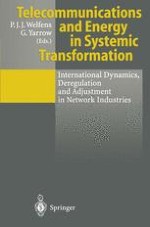1997 | OriginalPaper | Chapter
Telecommunications in Systemic Transformation: Theoretical Issues and Policy Options
Author : Paul J. J. Welfens
Published in: Telecommunications and Energy in Systemic Transformation
Publisher: Springer Berlin Heidelberg
Included in: Professional Book Archive
Activate our intelligent search to find suitable subject content or patents.
Select sections of text to find matching patents with Artificial Intelligence. powered by
Select sections of text to find additional relevant content using AI-assisted search. powered by
In OECD countries there are four major forces driving the liberalization of telecommunications: (i) national liberalization initiatives (e.g. US, UK, Sweden) which set a role model for other countries; (ii) the European Commission’s liberalization scheme with the magic date of 1998; (iii) US pressure on EU countries to open up their national market as a prerequisite for EU consortia to invest in the USA; (iv) strong technological dynamics in telecoms technologies and computer network development. Already in the 1990s the local loop is no longer a natural monopoly as wireless technology allows to bypass the national operator’s local terrestrial network. Moreover, with the expansion of the cable TV business and the option that electricity firms (grid companies) enter the telecoms market, there exist potential newcomers for the local network. In some countries the electricity grid companies will largely remain in the trunk (long distance) business, where they can easily add to competition. At the same time this will create new problems with regard to cost allocation because it is not clear to which extent the cost of adding optical fibres to the existing electricity network will be taken as the only marginal costs of telecoms network expansion, while an opportunity cost approach would include at least part of the depreciation of the existing pylons (WELFENS, 1995).
